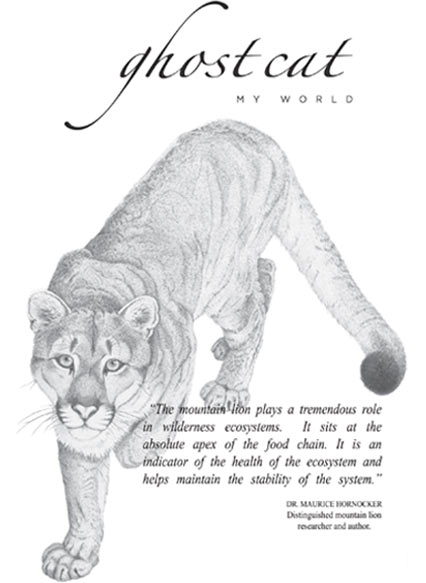
The Mountain Lion
"The mountain lion works a strong magic in the imagination of many Americans. It is
the ultimate loner, a renegade presence in the wildest canyons and wildest mountains,
the sign of everything that is remote from us, everything we have not spoiled.”
DONALD SCHUELER
There are as many names as there are stories surrounding the charismatic mountain lion: Puma concolor, cougar, catamount, painter, panther, ghost cat. The mountain lion represents a vividly wild aspect of the Americas. It is one of the last remaining great predators, whose elusiveness and camouflaged coloring have enabled it to survive a fifty dollar bounty and hunting pressures continuing to the present day.*
The mountain lion once roamed all of the Americas from the southern tip of Chile to the Canadian Yukon. With the European colonization of North America, it was hunted to extinction in regions east of the Rockies, with the exception of an endangered remnant population in Florida. Today, approximately 30,000 to 60,000 mountain lions exist in the US, and only 4,000 to 6,000 in California. Their elusiveness makes it difficult to know their exact numbers, but scientists believe there may be even fewer than these estimates.
This graceful, tawny colored cat has a small head, large body, and a long black-tipped tail. An adult weighs between 70 and 280 pounds, and measures five to nine feet from its nose to the tip of its tail (males being the larger). Large padded paws help the puma navigate through variable terrain. The paw print can be differentiated from that of a canine because its retractable claws do not appear in the tracks it leaves behind. Its binocular vision, lightning speed, sinewy strength, and strategically placed two-inch incisors, along with its razor-sharp claws, make this obligate carnivore, whose survival depends on fresh meat, a resourceful predator.
Pumas are solitary and territorial by nature, requiring vast tracts of contiguous land with ample prey and viable corridors connecting their populations. These large parcels of land and movement pathways enable them to disperse, find mates, raise their young and maintain genetic diversity. Their home ranges have been recorded from 10 to 400 square miles. Encroaching developments often divide and fragment puma habitat, splitting their home ranges and populations, resulting in additional sightings by humans.
The cougar plays a vital role in the ecosystem. They control deer, elk and other ungulate populations and also keep their hoofed prey on the move, thus preventing overgrazing. They often remove the weaker and diseased individuals, helping support healthy herds. These regulatory roles have a cascading effect on the entire food chain, designating the lion as a keystone species, one that helps maintain the delicate ecological balance. In addition, these top predators preserve the vitality of a living, breathing ecological community by leaving behind the remains of their prey. While deer are its principal food source, the puma is an opportunistic carnivore, eating everything from mouse to moose. Scavengers such as birds, skunks, bears, coyotes and foxes, all the way down to the smallest microorganisms, all capitalize upon the remains of a cougar kill.
We need to act now to preserve mountain lion habitat and in so doing a myriad of other species would be saved in the process. Once a species is added to the endangered list, hindsight sends us scampering to save it, always at a great expense and often with little success. Because pumas require large habitats, preserving their land and connecting corridors would also preserve that of the bear, the elk, birds, fish, frogs and an infinite number of other species.
At first glance, it may appear that an abundance of wildlands still exists, but a closer scrutiny reveals a different picture. With persistent development and the exponential growth of human populations, the next 100 years may well see the mountain lion on the verge of becoming yet another bygone predator, without which the environment, along with humanity, would suffer a great and irreplaceable loss. This great cat's power and mystery embody the very spirit of our land and signify the grandeur of nature itself. The puma is a wild, threatened, and ethereal symbol, and our missteps are mirrored in its suffering. It serves as a teacher and a beacon for humanity, reminding us of where we are going, where we have been, and ultimately, the direction in which we need to proceed with the ambition of securing a future for all life.
*Idaho was the first state to rescind its bounty program in 1958. Arizona did not repeal its mountain lion bounty program until 1990. California is the only state to ban hunting mountain lions for sport. This ban in California has been in effect since 1990. Depredations permits can be obtained to kill lions that destroy livestock or pets.
Coming soon: exhibition dates and book release date.